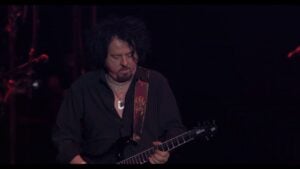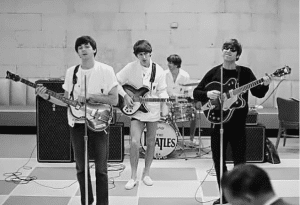10 1970s Rock Ballads That Fans Can Never Forget

Photo by Kevin Winter/Getty Images
The 1970s carried a special kind of magic for rock music. While the decade was known for its explosive riffs and stadium-shaking anthems, it was the ballads that revealed the heart beneath the noise. These slower, more thoughtful tracks had a way of stopping listeners in their tracks, pulling them into stories of passion, heartbreak, and longing.
What made these songs stand out wasn’t just their melodies but the way they connected so personally with people. A single lyric could feel like it was written for one person alone, even as millions sang along. They weren’t passing trends; they became emotional anchors tied to memories of youth, relationships, and defining life moments.
Even now, decades later, these ballads continue to echo through playlists, cover versions, and live performances. Their staying power proves that great rock music doesn’t fade with time—it lingers, reshaping itself for every new listener who discovers it. This list highlights ten of the most powerful examples from the ’70s, songs that still carry the weight of the era while speaking across generations.
“Stairway to Heaven” – Led Zeppelin, Led Zeppelin IV
Released in 1971, “Stairway to Heaven” quickly rose to legendary status as the centerpiece of Led Zeppelin IV. Written in a remote retreat in Wales, the track begins with a delicate acoustic guitar before gradually layering into blues flourishes and ending in a soaring climax. Robert Plant’s lyrics, delivered with a mystical edge, were famously said to have come in a moment of inspiration, adding to the song’s otherworldly aura.
Unlike most iconic tracks of the era, “Stairway to Heaven” was never released as a single, yet it became the most requested track in FM radio history. The use of a wooden recorder by John Paul Jones in the intro lent the ballad a haunting, medieval quality, setting it apart from contemporary rock offerings. Its mix of acoustic subtlety and electric grandeur created a new model for what a rock ballad could achieve.
The song’s influence stretches far beyond its initial release, standing as a defining example of storytelling in music. With its slow build and dramatic payoff, “Stairway to Heaven” has remained a rite of passage for both musicians attempting to play it and fans experiencing its emotional weight. Few songs capture both reflection and transcendence as seamlessly as this one.
“Bell Bottom Blues” – Derek and the Dominoes, Layla and Other Assorted Love Songs
“Bell Bottom Blues” emerged from Eric Clapton’s emotional turmoil in 1970, written during his longing for Patty Boyd. Recorded with Derek and the Dominoes, the song blends Clapton’s raw, aching guitar work with fragile vocals that reveal his vulnerability. Its restrained delivery makes it feel less like a grand performance and more like a private confession whispered to anyone who has ever felt unrequited love.
The band’s internal struggles, coupled with Clapton’s own battles, only heighten the authenticity of the track. Despite the chaos surrounding the group, “Bell Bottom Blues” is clean in its execution and unshakable in its emotional impact. The quiet guitar lines paired with Clapton’s pleading tone create a haunting intimacy that lingers long after the song ends.
As one of Clapton’s most personal performances, the ballad resonates deeply with listeners who recognize the desperation and yearning woven into every note. It stands out not just as a standout track from Layla and Other Assorted Love Songs, but as one of the purest examples of vulnerability in rock music.
“Angie” – The Rolling Stones, Goats Head Soup
“Angie,” released in 1973 on Goats Head Soup, revealed a tender side of The Rolling Stones that contrasted sharply with their usual rebellious swagger. Driven by Nicky Hopkins’s piano and Keith Richards’s acoustic guitar, the song carries a weary sense of regret, reinforced by Mick Jagger’s uncharacteristically fragile vocal delivery. It is a ballad steeped in sadness, apology, and reflection.
Speculation has long surrounded the identity of “Angie,” with theories ranging from David Bowie’s wife to Clapton’s muse Patty Boyd. Richards himself clarified that the title was inspired by his newborn daughter, though the ambiguity only deepened the track’s mystique. Regardless of who the namesake was, the real power of the ballad lies in its atmosphere of heartbreak and resignation.
The song has endured as one of the Stones’ most heartfelt works, showing the band’s ability to move beyond swagger into delicate emotional territory. “Angie” remains a staple of their catalog and a rare glimpse into their softer, more vulnerable side.
“Dream On” – Aerosmith, Aerosmith
Steven Tyler wrote “Dream On” in his teenage years, and when Aerosmith recorded it for their 1973 debut album, it immediately set itself apart from the rest of the record. The track’s somber minor chords and gradual build give way to one of rock’s most powerful vocal climaxes, with Tyler’s wails capturing both defiance and desperation. The cracks in his voice only reinforce its raw intensity.
At the time, the song was unlike much of Aerosmith’s catalog, which leaned heavier on swaggering rock energy. Instead, “Dream On” delivered a swelling emotional arc that made it stand out among the harder-edged tracks. Its sincerity resonated with listeners who saw it not just as a song but as a message about resilience and the pursuit of dreams.
Decades later, “Dream On” has become synonymous with Aerosmith, serving as both their signature ballad and a universal anthem. Its enduring appeal lies in its simple but powerful message—an ode to holding on in the face of adversity that continues to inspire generations.
“Free Bird” – Lynyrd Skynyrd, (Pronounced ‘Lĕh-‘nérd ‘Skin-‘nérd)
“Free Bird” stands as Lynyrd Skynyrd’s most iconic track, starting as a tender ballad before transforming into one of rock’s most electrifying guitar showcases. Written by Allen Collins and Ronnie Van Zant, the song began as a personal reflection on love and independence before blossoming into a multi-part epic that redefined the boundaries of a rock ballad.
Its gradual shift from delicate verses to thunderous dual-guitar solos gave it a unique emotional arc. The song’s themes of freedom, parting, and resilience struck a chord with listeners, making it an anthem for anyone facing life’s difficult goodbyes. Over time, it became the band’s defining number, a centerpiece of their live shows, and a fan request shouted at countless concerts across genres.
“Free Bird” has since transcended its origins, symbolizing both the pain of letting go and the exhilaration of liberation. Its iconic guitar outro remains one of the most celebrated in rock history, cementing its place as not just a ballad but a monumental statement of what 1970s rock could achieve.
“Love Hurts” – Nazareth, Hair of the Dog
Though first recorded by The Everly Brothers and later by Roy Orbison, it was Nazareth’s 1974 version of “Love Hurts” that truly etched the song into rock history. The band’s rendition stripped away the polish of earlier recordings, replacing it with a heavier, more visceral sound. Dan McCafferty’s gravelly vocals carried a raw intensity that perfectly mirrored the song’s aching theme of heartbreak.
On Hair of the Dog, the track became a standout moment, channeling universal pain through distortion, soaring guitar tones, and unflinching honesty. The vulnerability behind the words resonated deeply, and the song’s extended run on international charts, including an astonishing 60 weeks in Norway, proved its global impact.
Even decades later, “Love Hurts” remains a definitive anthem of wounded love. Its bruised sincerity, paired with Nazareth’s hard rock grit, created a version that continues to echo as one of the ‘70s’ most memorable ballads of heartbreak.
“Dust in the Wind” – Kansas, Point of Know Return
What began as a fingerpicking exercise for guitarist Kerry Livgren transformed into one of the most haunting ballads of the decade. Released in 1977 on Point of Know Return, “Dust in the Wind” showcased a side of Kansas that contrasted with their usual progressive rock bombast. Instead of electric riffs, the song leaned into delicate acoustic guitars, violin lines, and lyrics inspired by the biblical book of Ecclesiastes.
Its understated approach struck a chord with audiences, offering a moment of quiet reflection amid the louder landscape of ‘70s rock. The refrain, “all we are is dust in the wind,” captured existential truths with an elegance that proved less can indeed be more.
“Dust in the Wind” became Kansas’s biggest hit and has endured as a timeless meditation on mortality. Its beauty lies in its simplicity, reminding listeners of life’s fleeting nature and urging them to appreciate each moment.
“Simple Man” – Lynyrd Skynyrd, (Pronounced ‘Lĕh-‘nérd ‘Skin-‘nérd)
Recorded in 1973, “Simple Man” was born from Ronnie Van Zant’s conversation with his grandmother, who shared words of wisdom about love, humility, and living an honest life. The song’s message was straightforward yet profound, offering life advice wrapped in gentle southern rock. It revealed another side of Lynyrd Skynyrd, one that valued reflection as much as rebellion.
Gary Rossington’s steady guitar riffs and Van Zant’s sincere vocal delivery gave the song a grounded authenticity. Its slow-burning structure allowed the lyrics to take center stage, resonating with anyone searching for guidance during pivotal life moments.
“Simple Man” has since become an anthem at funerals, graduations, and other milestones, a track that bridges generations with its timeless truths. It continues to be cherished for the way it distills complex life lessons into a heartfelt ballad.
“Beth” – KISS, Destroyer
For a band known for fire-breathing theatrics and face paint, “Beth” was an unexpected but welcome departure. Drummer Peter Criss first penned the song out of frustration during long rehearsals, channeling the longing and strain of life on the road. Released on 1976’s Destroyer, the track featured strings, piano, and Criss’s tender vocals instead of the band’s usual hard rock fury.
Producer Bob Ezrin recognized its potential and encouraged KISS to record it properly, and the gamble paid off. “Beth” reached number seven on the Billboard Hot 100, becoming the band’s highest-charting single and introducing a completely different side of their music to the world.
The ballad remains one of KISS’s most surprising achievements—a quiet, vulnerable love letter that resonated just as strongly as their loudest rock anthems. “Beth” proved that even a band built on spectacle could create something deeply personal and emotionally lasting.
“Time” – Pink Floyd, The Dark Side of the Moon
From the moment its opening clock chimes ring out, “Time” sets itself apart as one of Pink Floyd’s most profound works. Featured on 1973’s The Dark Side of the Moon, the song reflects on the fleeting nature of life and the tendency to let time slip away unnoticed. Roger Waters’s lyrics serve as a stark reminder that youth fades quickly, urging listeners to seize the present before it’s gone.
David Gilmour’s vocals, weary yet powerful, give the words extra weight, while his soaring guitar solo captures both regret and urgency. The interplay of vocals and instrumentation creates a ballad that is equal parts haunting and cathartic.
More than just another track on a legendary album, “Time” remains one of rock’s great meditations on existence. It continues to resonate with listeners as both a warning and an inspiration, cementing its place as one of the decade’s most emotionally stirring ballads.





















